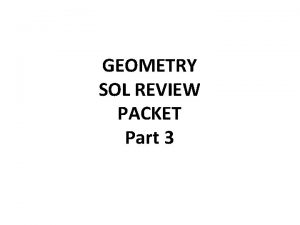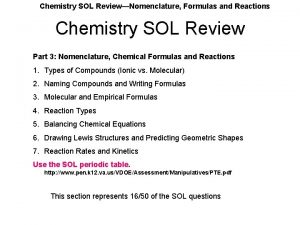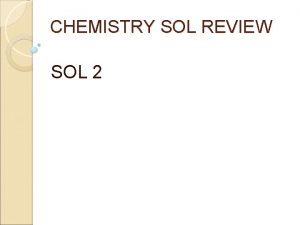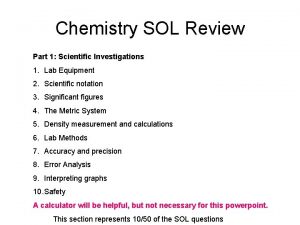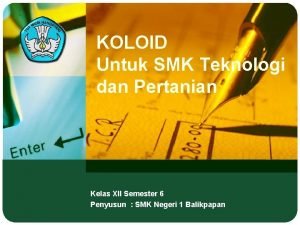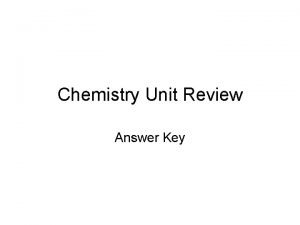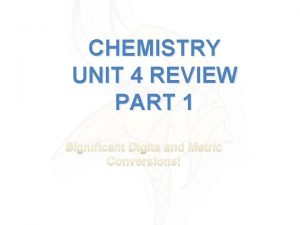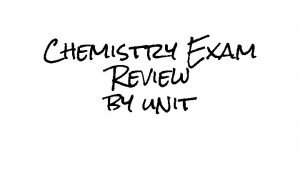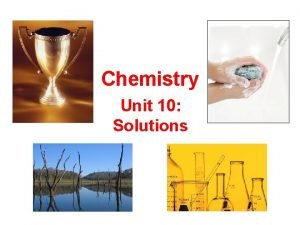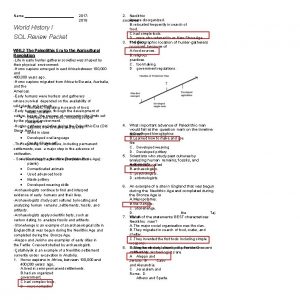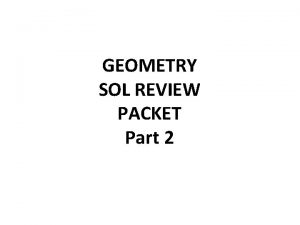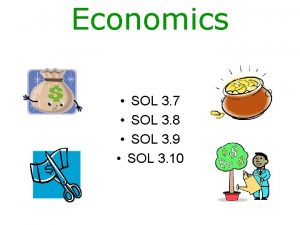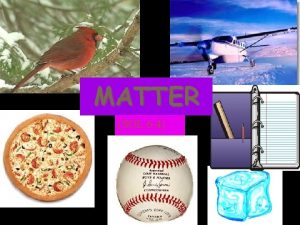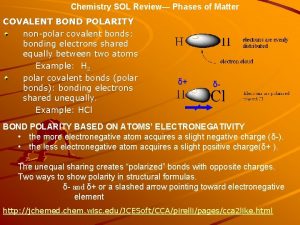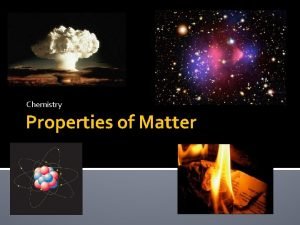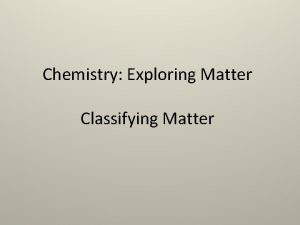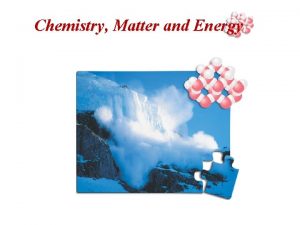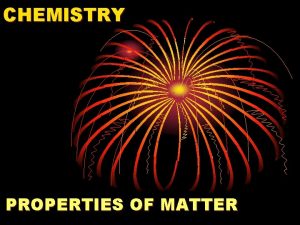CHEMISTRY SOL REVIEW DAY 1 UNIT 2 Matter


















- Slides: 18

CHEMISTRY SOL REVIEW DAY 1

UNIT 2 - Matter is anything with mass & _______ Volume ____ substances are types of matter with definite & uniform characteristics. Pure For example, _____ contain only one kind of atom. Elements

UNIT 2 - Matter A _____ is another pure substance that is made of more than one type of atom & can only be broken down by chemical means. Compound _______ are types of matter with 2 or more substances that can vary in composition & properties Mixtures

UNIT 2 - Matter A _______ mixture has a uniform composition (Stainless steel, Kool. Aid) Homogeneous _____ is considered the universal solvent Water The particles dissolved in a solvent are called the _____ Solutes A _____ is really a heterogenous

UNIT 2 - Matter Phase changes are _____ changes (physical or chemical) Physical The process of a solid becoming a gas (without becoming a liquid first) is ___ Sublimation What state of matter has the strongest IMF? Solid

UNIT 2 - Matter Name the 4 things used as evidence of a chemical reaction occurring Production of a gas (odor or bubbles) Color change Release/absorption of energy (light or heat) Forming a precipitate (chunks ) Name a way to separate a mixture Filtration, distillation, chromatography, centrifuging, decanting

UNIT 3 – History of the Atom 5 part atomic theory – all matter made of atoms Dalton Cathode Ray Tube experiments, Plum Pudding model, Electrons have mass & a negative charge JJ Thomson

UNIT 3 – History of the Atom Passed alpha particles through gold foil and found that the nucleus is dense and positively charged Rutherford Electrons found in levels or shells around the nucleus Bohr An electron passed through an electric field will bend ____ Toward the positive

UNIT 3 – History of the Atomic number gives us # of ____ in an atom of each element Protons Mass number is calculated by adding __ Protons plus neutrons Different isotopes have different #s of __ Neutrons Different __ have different #s of

UNIT 3 – History of the Atom Calculate the average atomic mass of copper if copper has 2 isotopes. 69. 1% has a mass of 62. 93 amu and the rest has a mass of 64. 93 amu. (. 691 * 62. 93) + (. 309 * 64. 93) 63. 55 Flourine – 19 has how many neutrons? 10 What is the molar mass of carbon?

UNIT 3 – History of the Atom You find an artifact with a C-14: C-12 ratio that is 1/16 the modern ratio. The half life of C-14 is 5715 years. How old is the artifact? 22860 years Alpha, Beta, & Gamma particles are all given off by radioactive decay. Why are gamma rays the most dangerous? (Answer should involve size & penetration) Tiny so they can penetrate the farthest –

UNIT 4 – Electron Configuration What is the longhand electron configuration for N? 1 s 2 2 p 3 For Fe? 1 s 2 2 p 6 3 s 2 3 p 6 4 s 2 3 d 6 What is the shorthand config for Ca? [Ar] 4 s 2 The electrons in the outermost shell are called the _______ electrons Valence

UNIT 4 – Electron Configuration How many p orbitals are there? 3 What shape is a p orbital? Bowtie or dumbbell or figure 8 How many electrons can be held in d orbitals? 10

UNIT 4 – Electron Configuration How many valence electrons does oxygen have? 6 The rows in the periodic table are called Periods Draw a Lewis dot diagram for Nitrogen When an electron returns to its ground state after being excited, it releases energy and emits a _____, or a particle

Unit 5 – The Periodic Table The elements on the right side of the staircase are _____ Nonmetals The first column or group of elements are called the ____ Alkali metals Group 7 is called the ___ Halogens

UNIT 5 – The Periodic Table The d-group elements are called the __ Transitional metals The f-block elements are called the ___ Inner transition metals What happens to atomic radius as you move from top to bottom down the periodic table? Gets bigger

UNIT 5 – The Periodic Table The energy required to remove an electron from an atom is called __ Ionization energy What happens to ionization energy as you move from left to right across a period? Gets bigger An atoms affinity for electrons in a compound is called its ___ Electronegativity

ANNOYING 2009 Question Potassium (K) has a smaller atomic mass than (Ar) even though the atomic number of potassium is larger than the atomic number of argon. Which of the following BEST accounts for this observation? F At STP, K is in the solid phase, but argon is gas G It is easier for a potassium atom to lose an electron than it is for an argon atom H The most common isotopes of argon have more protons than the most common isotopes of potassium. J The most common isotopes of potassium have fewer neutrons than the most common isotopes of
 Day 1 day 2 day 3 day 4
Day 1 day 2 day 3 day 4 Chemistry sol review packet
Chemistry sol review packet Chemistry sol review
Chemistry sol review Chemistry sol review
Chemistry sol review Chemistry sol review
Chemistry sol review Chemistry sol review
Chemistry sol review Chemistry sol practice
Chemistry sol practice Chemistry sol review
Chemistry sol review Unit 10, unit 10 review tests, unit 10 general test
Unit 10, unit 10 review tests, unit 10 general test Day 1 day 2 day 817
Day 1 day 2 day 817 Contoh koloid liofob
Contoh koloid liofob Chemistry semester 2 review unit 12 thermochemistry
Chemistry semester 2 review unit 12 thermochemistry Chemistry unit review answer key
Chemistry unit review answer key Chemistry unit 4 review answers
Chemistry unit 4 review answers Unit 6 chemistry review
Unit 6 chemistry review Sol'n chemistry
Sol'n chemistry Va studies 4th grade sol review
Va studies 4th grade sol review World history ii sol review packet
World history ii sol review packet Geometry sol review packet
Geometry sol review packet

